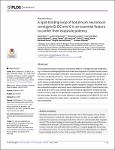A lipid-binding loop of botulinum neurotoxin serotypes B, DC and G is an essential feature to confer their exquisite potency
Stern, Daniel
Weisemann, Jasmin
Le Blanc, Alexander
von Berg, Laura
Mahrhold, Stefan
Piesker, Janett
Laue, Michael
Luppa, Peter B.
Dorner, Martin B.
Dorner, Brigitte G.
Rummel, Andreas
The exceptional toxicity of botulinum neurotoxins (BoNTs) is mediated by high avidity binding to complex polysialogangliosides and intraluminal segments of synaptic vesicle proteins embedded in the presynaptic membrane. One peculiarity is an exposed hydrophobic loop in the toxin’s cell binding domain HC, which is located between the ganglioside- and protein receptor-binding sites, and that is particularly pronounced in the serotypes BoNT/B, DC, and G sharing synaptotagmin as protein receptor. Here, we provide evidence that this HC loop is a critical component of their tripartite receptor recognition complex. Binding to nanodisc-embedded receptors and toxicity were virtually abolished in BoNT mutants lacking residues at the tip of the HC loop. Surface plasmon resonance experiments revealed that only insertion of the HC loop into the lipid-bilayer compensates for the entropic penalty inflicted by the dual-receptor binding. Our results represent a new paradigm of how BoNT/B, DC, and G employ ternary interactions with a protein, ganglioside, and lipids to mediate their extraordinary neurotoxicity.
Files in this item

